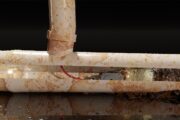(BPT) – Researchers predict that rising water prices could mean within five years a third of American households will not be able to pay their water bills, despite the replenishment of water reserves around the country.
What’s more, the National Weather Service warns that drought could increase or reoccur if the country experiences a period of sustained heat and dryness.
Fortunately, there are many ways for you to reduce the amount of water your home uses each year. One of the best places to start conserving water is in the bathroom, where toilet flushing, long showers and deep soak baths account for the largest portion of a home’s water consumption, according to the U.S. Geological Survey.
Here are simple ways you can significantly reduce your home’s water consumption, lower your water bill and do something good for the environment:
Ditch water-guzzling fixtures
Flushing the toilet accounts for about 30 percent of a home’s annual water consumption, making it the largest user of water in the home, according to the U.S. EPA. Prior to 1994, most toilets used 3.5 or more gallons of water per flush (gpf). Current federal guidelines require that toilets use no more than 1.6 gpf, but you can do even better.
* Toilets: Replace dated, older toilets with ultra-high-efficiency models like the American Standard H2Optimum ultra-high efficiency toilet, which uses an average of 1.1 gpf — that’s 31 percent less than federal mandates. Exclusive PowerWash siphon-jet bowl cleaning technology drives this water-saving toilet to remove every trace of paper and waste, while its EverClean antimicrobial finish helps it stay cleaner, longer.
* Faucets: Inefficient and leaky bathroom faucets also waste thousands of gallons of water each year. WaterSense-labeled faucets use a maximum of 1.5 gallons per minute (gpm) and as little as 1.2 gpm, decreasing water use by 30 percent or more. The Fluent collection of high-efficiency bathroom faucets uses leading-edge technology to reduce water consumption, while producing a strong flow rate, all with high-style design to coordinate with various bathroom decors.
* Showerheads: A significant source of water usage in a home can be attributed to showerheads, pouring up to 40 gallons per day down the drain for an average family, according to the EPA. Since showers account for 17 percent of a home’s water use, replacing an older, less efficient showerhead with a WaterSense-certified one can curb waste in the shower. An example is the Hydrofocus 6-function showerhead that uses only 2 gallons of water per minute, while delivering a concentrated and invigorating spray. Its innovative pressure-compensating operation features a plentiful water flow across all spray patterns for a customized showering experience that caters to your family’s personal preferences.
Make easy habit changes
Replacing inefficient fixtures is an investment that will pay off over time. However, there are simple habit changes that are free and will produce results right away. Your family can easily reduce water use in the bathroom by:
* Turning off the water when brushing their teeth. Running the tap while brushing can waste as much as 3,000 gallons per year, the EPA says.
* Taking showers instead of baths. It takes an average of 36 gallons to fill the bathtub. Plus, if you take baths less often, when you do indulge in one it will feel like a treat.
* Taking shorter showers. The longer the shower runs, the more water goes down the drain. Never turn on the shower and walk away to do other things while the water warms. If you get delayed or distracted, the water could run for a long time before you actually step into the shower.
* Washing hands in cold water with soap, rather than letting the water run until it gets hot.
* Shaving at the sink, rather than in the shower. Shaving in the shower extends your shower time, unnecessarily consuming more water. Just don’t forget to turn off the water while shaving at the bathroom sink.
Taking steps to reduce bathroom water usage can help save you money in the short term and benefit the environment in the long run. These changes are simple to implement, with rewarding results to both your wallet and our planet Earth.


